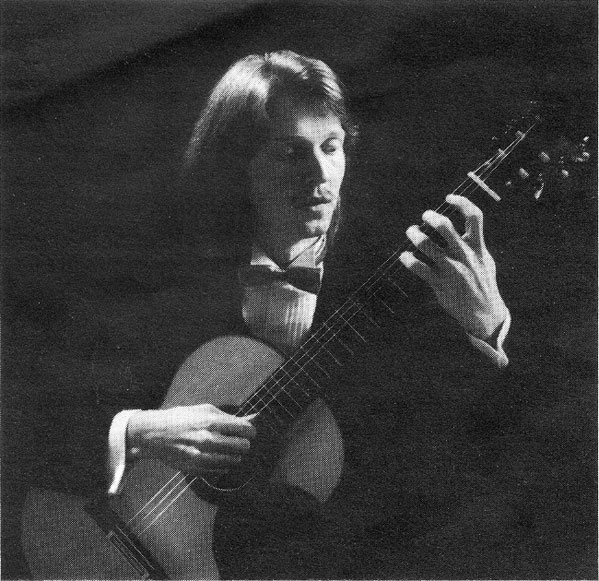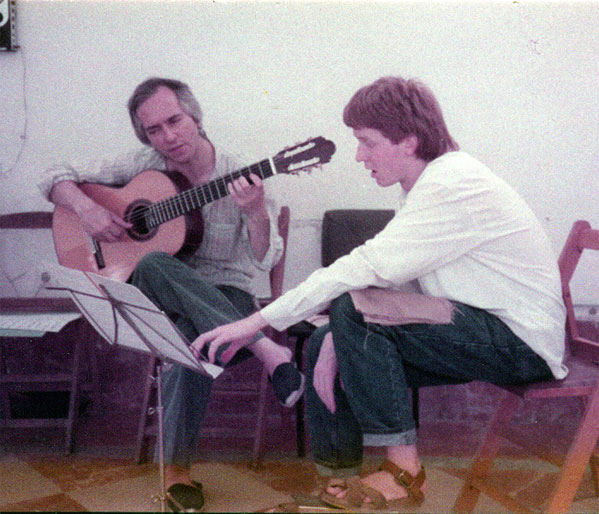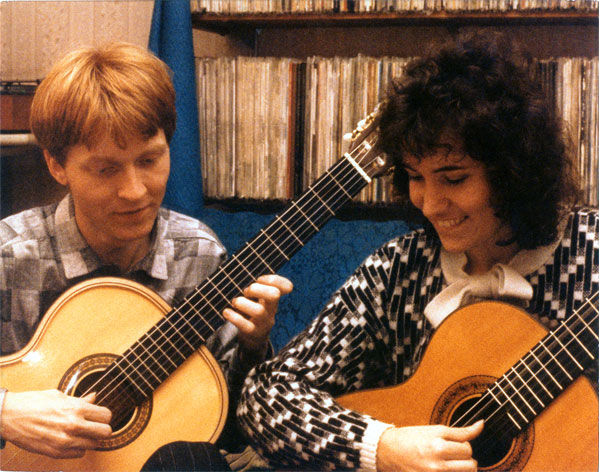Wulfin Lieske
interviewed (in London) in 1985

The transcription of the Schubert Minuet here is by a fast-rising young German guitarist called Wulfin Lieske. Born in 1956, he started playing at the age of twelve, and studied at Cologne Conservatory and University; then with (among others) Hubert Käppel, Oscar Caceres, José Tomás and Oscar Ghighlia.
I first met Wulfin at Paco Peña's festival in Córdoba last year, and thought then that he was one of the best young guitarists I had heard. At that time he passed on to me the cassette of Bach and Schubert that received a rave review from John Duarte in the December issue [of Guitar International]. It now transpires that this tape was only a pre-release test recording, unedited, and the new commercial tape (now available in England from the London Guitar Studio) is even better. A compact disc of it was issued in July, and the record followed in October. The transcriptions (one reviewed in July) have just been published.
I met Wulfin again during his last short visit to England, and learnt then that he had won the Segovia competition in Almuñécar in December, with only three weeks’ preparation.
Since he is clearly destined to go places, I took the opportunity of asking him about his music, his career so far, and his recording.

I didn't realise that was just a test recording you gave me.
Yes. We wanted to do an LP which would also be published a a compact disc, so we decided to make a digital recording from start to finish. We chose a locality with fantastic natural acoustics, in a castle in Rastadt, which is close to Karlsruhe. The marvellous thing was that if you analyse the frequency of the reverberation, it is absolutely identical to the primary frequency; that is, the original sound of the guitar is reverberated. Sometimes you have places where just the bass reverberates, or there is a strange treble, or you get a harsh sound or a damped sound. But with this we got the complete range; and for the Schubert this is very important, because if you listen to the first piece you will discover that there are long rests (well actually they are not always rests, sometimes it is just a chord which has to sound, and that's the problem of the guitar—sustain). I recorded on a 1982 Marín, which has a very good sustain, and with this hall (it's a concert hall, for about 150 people), it gave very good results, together with the digital recording.
Now, as you know, digital editing is coming into general use now, but it's still a bit extraordinary and expensive. So we decided just to check the hall and record the programme, and see what came out. We had mobile digital equipment, just got two good microphones, tried the position, and recorded. So the tape I gave you was the result of this first recording, without editing.

Two months later, after playing a festival and a small tour of Germany, I made the final disc1.
How did you come to enter the Segovia competition?
Well, there are a lot of Segovia competitions. But this one was in Almuñécar. Segovia has his winter domicile there, its a fine—more than a house, more like a mansion—where we can look down to the Mediterranean.
This year was the first time, and I learned about it by accident. In Cologne I got a call from Manuel López Bellido (which was nice, because I play a Marín—but we're friends). And he said, Have you heard about the competition? This was only three weeks before, and there were a lot of set pieces: Capriccio Diabolico (Castelnuovo-Tedesco), Sevillanas (Turina), Study Nº 7 (Villa-Lobos), and you could choose two movements from the Suite Compostelana by Mompou. Once I had decided to take part, I phoned Bellido and asked him to register for me, because the deadline was the 22nd of December, and it was already the 19th. At the same time I sent them a telegram to say I was coming.
In Almuñécar it was quite cold, like everywhere in Europe, and the competition took place in a big church with only four small heaters; and this little bit of warmth disappeared into the top of the church.The audience were sitting in their coats, freezing; and so did we, in our tuxedos—I'm not complaining, I'm just telling what happened. Segovia caught a cold, too.
Finally, do you have any remarks for the readers about the piece [presented here]?

First of all, pay attention to all the voices, not just the nice melodies. You have to get the feel of all the changes of harmony, and most important, the feeling of the rhythm. You must remember that it's a Minuet, which is a thing forgotten by some guitar interpreters; and it's allegretto. This gives a hint of the tempo, it's not too slow: and if you listen to the piano versions you will find everybody plays it quite quickly. Anyway, in the Sonata it follows after a slow movement, so it is quite brisk. In this transcription, by the way, I gave it all the articulations as they are in the urtext, which is published by Henle.
Actually, there aren't too many markings originally; but those that are in must be observed—for instance, if Schubert writes dots and at the same time makes a slur, that means to connect a staccato phrase (which is not a contradiction, of course). And dynamics: there are a lor of pianissimos and triple-pianos, especially in the Trio (which is maybe played a bit more slowly than the Minuet, although that's up to the individual). But the Trio is something different, so you have to get an idea about What is a Trio? Well, it was a three-part section in a work: if you had an orchestral piece, you suddenly had a section in the middle with three voices. So always the Trio was something reduced, something intimate. And in Mozart, for example, in the minuets the Trios have a very popular character, folk-like. But here in the Schubert it's the other way around, it's a very introverted part; and he wrote pp and ppp, so it's very quiet. Then suddenly he makes a crescendo, and writes mezzoforte, and this is really an event for Schubert, it means something great is happening. And this is really a problem to the guitar world, too many people have just one range of dynamics.
So I'm always looking to bring out what is intended; and if Schubert took his pen and wrote ppp, he had a reason for that, and likewise if he goes up to mezzoforte. Then suddenly there comes a fortissimo, that really is the explosion then; and all this is given in the Minuet, and that is one of the fantastic aspects, not just the famous melody, there are a lot of things, it's a masterpiece.
Notes
1Klassische Meisterwerke (Intercord 830.804).

Further Information
Wulfin’s website, which includes a complete discography, may be found here.